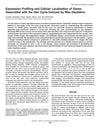TLDR Cathepsin E is crucial for normal skin cell differentiation and development.
The study explored the role of cathepsin E (CatE) in keratinocyte terminal differentiation. It was found that CatE deficiency in mice led to abnormal keratinocyte differentiation, characterized by expanded corium and reduced subcutaneous tissue and hair follicles. In skin papilloma models, CatE deficiency resulted in reduced expression and altered localization of differentiation proteins keratin 1 and loricrin. In vitro studies confirmed CatE's involvement in regulating epidermal differentiation proteins. Overexpression of CatE enhanced keratinocyte differentiation, while deficiency delayed it, suggesting CatE's crucial role in regulating epidermis formation and homeostasis.
36 citations
,
March 2009 in “Molecular Carcinogenesis” Disrupting Bcl-xL in mice reduces skin cancer risk.
 1039 citations
,
February 2009 in “Nature Reviews Molecular Cell Biology”
1039 citations
,
February 2009 in “Nature Reviews Molecular Cell Biology” Skin stem cells are crucial for maintaining and repairing the skin and hair, using a complex mix of signals to do so.
 27 citations
,
August 2005 in “The journal of investigative dermatology/Journal of investigative dermatology”
27 citations
,
August 2005 in “The journal of investigative dermatology/Journal of investigative dermatology” Researchers found new genes involved in hair growth, which could help develop new hair treatments.
118 citations
,
January 2004 in “European Journal of Cell Biology” Balanced protease activity is crucial for healthy skin and hair development.
66 citations
,
October 2002 in “Human molecular genetics online/Human molecular genetics” A gene mutation in mice causes skin defects and early death.
324 citations
,
May 2002 in “Oncogene” 27 citations
,
July 1997 in “PubMed” The harlequin ichthyosis mouse mutation causes thick skin and early death, resembling a human skin disorder.
33 citations
,
March 1994 in “PubMed” High ODC and low K1 and K10 may indicate early skin tumors in mice.
1 citations
,
October 2023 in “PROTOPLASMA” April 2019 in “The journal of investigative dermatology/Journal of investigative dermatology” A specific mutation in the TRPV3 gene causes hair follicle cells to develop improperly, leading to hair loss.
 3 citations
,
July 2011 in “Folia Histochemica et Cytobiologica”
3 citations
,
July 2011 in “Folia Histochemica et Cytobiologica” Calcium reduces involucrin in rat hair bulbs but doesn't affect filaggrin and Kdap.
9 citations
,
July 2008 in “Archives of Dermatological Research” 18 citations
,
June 1993 in “Archives of Dermatological Research” Human hair follicles can be used to create skin-like tissue for wound healing and drug testing.



